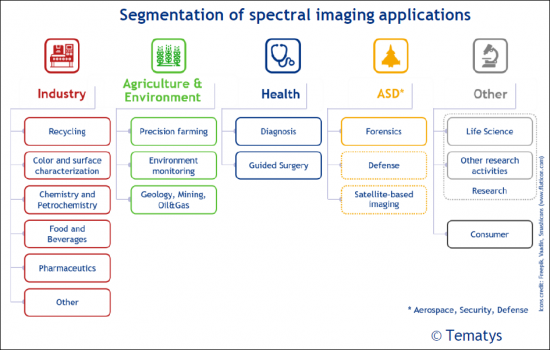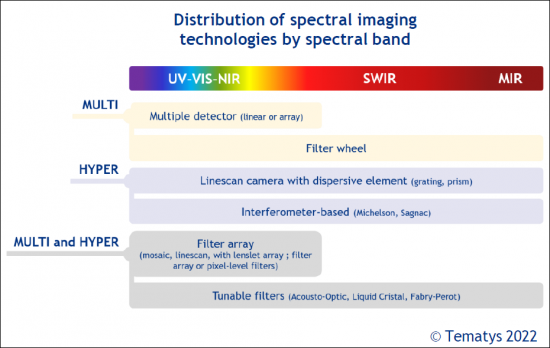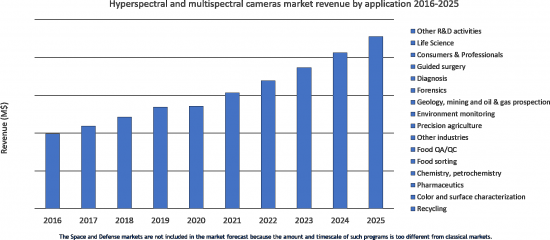 |
市場調查報告書
商品編碼
1127459
光譜成像:最終用戶需求、市場和趨勢 (2022) - 高光譜和多光譜相機成為針對現場和在線應用的低成本工具Spectral Imaging: End-User Needs, Markets and Trends (2022) - Hyperspectral and Multispectral Cameras are Becoming Lower Cost Tools to Target On-field and In-line Applications |
||||||
處於轉折點的市場
光譜成像(包括高光譜和多光譜),用於從衛星和飛機進行地球觀測,自 2000 年代初以來已被工業界用於分類目的。.分揀是目前多光譜和高光譜相機最大的市場,收入也很大。
目前,光譜成像市場正處於發展的轉折點。以不到 10,000 美元的成本,正在進行一項技術努力,以製造一種足夠緊湊的相機,以便在無人機和工業生產線上實施。同時,還開發了一種穩健且易於使用的光譜數據分析方法。這些成就有望促進多/高光譜相機在現場和內聯中的普及。預計未來幾年光譜成像市場的複合年增長率將達到 20% 左右,到 2024 年銷量將超過 10,000 台(不包括太空和軍事市場)。

由社會問題驅動的市場
光譜成像可以結合空間和化學信息,解決三大工業和社會挑戰。
- 預計工業 4.0 的部署將推動對能夠實現複雜測量的經濟高效的智能傳感器的高需求。
- 對可持續和安全食品生產的需求:需要以高產量擴大大片區域,以便為不斷增長的人口提供優質食品。
- 個性化醫療的發展:需要能夠實現快速可靠診斷的無標籤、非侵入性、緊湊型工具。
對這種低成本和高級分析的需求將推動高光譜和多光譜相機在現場和在線應用中的採用。高增長市場包括食品和飲料、精準農業、顏色和表面表徵、氣體檢測、藥品質量保證/控制和醫療。

以低成本實現高級分析的技術開發
現場和工業應用需要低成本、便攜且易於使用的系統。在硬件和軟件層面取得了技術突破,降低了光譜相機的成本和尺寸,簡化了數據處理方法。
最近,已經使用了創新技術,例如在 CMOS 檢測器上進行晶圓級過濾器沉積,以及集成多個檢測器陣列的相機設計。
借助這些技術,相機的價格現在達到了 5,000 美元到 12,000 美元之間。需要進一步取得進展才能達到 1,000-5,000 美元的目標價格,以供廣泛的現場和工業採用。

在本報告中,我們分析了全球光譜成像市場,包括市場的最新情況和基本結構、按類型(多光譜相機、高光譜相機)以及按應用和光譜波段(數量為單位)。□金額基礎),技術概述和比較,預期的應用領域,數據處理在未來市場發展中的重要性,最終用戶的要求和對策。
內容
執行摘要
簡介
分析總結
處於臨界點的市場
- 驅動因素:對低成本高級分析的需求
- 價值鍊和市場定義
- 市場參與者(2022 年)
- 市場數據和預測(2017-2025 年)
- 市場分析和遺留問題
軟硬件技術趨勢
- 簡介
- 商業技術細分
- 多光譜成像技術:
- 空間掃描
- 快照
- 頻譜掃描
- 高光譜成像技術:
- 空間掃描
- 快照
- 頻譜掃描
- 每個光譜帶的技術和相機成本
- 數據處理層:走向面向應用的解決方案
光譜成像的現狀和有希望的未來應用領域
- 當前狀態
- 下一個需要解決的大市場
- 工業 4.0(顏色/表面表徵、製藥)
- 可持續食品生產和食品安全(精準農業、食品選擇、食品質量控制)
- 個性化醫療(醫學診斷、引導手術)
附錄
Hyperspectral and multispectral cameras are becoming low cost tools to target on-field and in-line applications.
Objectives of the report:
- Underline how spectral imaging can address key economical and societal challenges,
- Provide market data and forecast of spectral imaging cameras by application and by spectral band,
- Describe and benchmark the numerous hyperspectral and multispectral available technologies,
- Identify the most promising applications of hyperspectral and multispectral cameras,
- Highlight the importance of data processing in the development of the spectral imaging market,
- Understand end-users requirements for each Application, and the challenges to overcome for a wider adoption of spectral imaging.
Key Features of the report:
- Market revenue breakdown between multispectral and hyperspectral cameras
- Spectral imaging cameras market forecast by applications
- Benchmarking of different spectral imaging technologies
- Analysis of most promising applications
A market at a turning point
First introduced for earth observation from satellites and planes, spectral imaging (including hyperspectral and multispectral imaging) was adopted in industry in the 2000's, for sorting applications. Sorting is currently the biggest market of multispectral and hyperspectral cameras, in revenue.
The adoption in other industrial or in on-field applications remained low for three main reasons: the high cost of cameras, their large size and the huge amount of data to process and store. Currently, the spectral imaging market is at a turning point in its evolution. Technical efforts have been made to build cameras at cost below $10,000 and compact enough to be implemented on drones or in industrial lines. Meanwhile, robust and user-friendly methods for spectral data analysis have been developed. These achievements will lead to a wider adoption of multi/hyperspectral cameras for on-field or in-line applications. The spectral imaging market is expected to experience a high annual growth rate of around 20% in the coming years, reaching more than 10 000 cameras sold in 2024 (excluding the Space and Military markets).
The report provides the breakdown between multispectral and hyperspectral cameras. It also includes detailed market revenue and units forecasts by application and detailed analysis by market segment.

A market driven by societal challenges
With its ability to combine spatial and chemical information, spectral imaging addresses 3 major industrial and societal challenges:
- The deployment of industry 4.0, which induces a high demand for cost-effective smart sensors able to provide complex measurements,
- The need for sustainable and safe food production, which requires measurements on large areas and at high throughput to provide high food quality for an ever growing population,
- The development of personalized healthcare, that implies the need of label-free, non invasive and compact tools, giving a fast and reliable diagnosis.
These demands for low cost advanced analysis will drive the adoption of hyperspectral and multispectral cameras into on-field and in-line applications markets that will experience a high growth are Food & Beverages, Precision Agriculture, Color and Surface Characterization, Gas sensing, Pharmaceutics QA/QC, and Medical applications in the long-term.
In this report, we provide a detailed analysis of current and most promising applications of spectral imaging cameras. We describe the end-users needs and the remaining challenge for their widespread adoption in these markets.

Technology developments meet the demand for low cost advanced analysis
In on-field and industrial applications, the demand for low cost portable and easy-to-use systems is high. Technological breakthroughs are undertaken at hardware and software levels to decrease cost and size of spectral imaging cameras and simplify the data processing methods.
Recent advances take advantage of innovative technologies like deposition of filters on CMOS detectors at wafer level or innovative designs of cameras integrating multiple detector arrays.
With these technologies, cameras currently reach cost of $5 000 to $12 000. Further progresses are necessary to achieve the target price of $1 000 to $5 000 for broad adoption on field or in industry.

Table of Contents
Executive Summary
Introduction
- Study goals and objectives
- Information sources and methodology
- Glossary
- Context and Definitions
- Scope of the report
- List of companies
Highlights of the report
A market at a turning point
- Driver: demand for advanced analysis at lower cost
- Value chain and market definition
- Market players 2022
- Market data and forecasts 2017-2025
- Market analysis and remaining challenges
Hardware and software technology trends
- Introduction
- Segmentation of commercial technologies
- Multispectral imaging technologies:
- Spatial scanning
- Snapshot
- Spectral scanning
- Hyperspectral imaging technologies:
- Spatial scanning
- Snapshot
- Spectral scanning
- Technologies and cameras cost by spectral bands
- Data processing layers: towards application-oriented solutions
Spectral imaging current status and promosing applications
- Current status
- Next big markets to be addressed
- Industry 4.0 (Color and surface characterization, Pharmaceutics)
- Sustainable food production and food safety (Precision farming, food sorting and Food quality control)
- Personalized Health (Medical diagnosis and guided-surgery)
Appendices
- Methodology
- About TEMATYS













